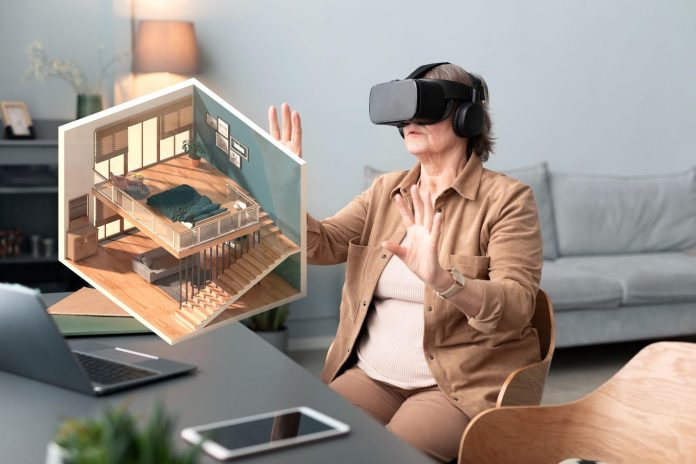How Virtual Reality is Transforming Interior Design Industry
Virtual reality (VR) technology, once the domain of
futuristic fantasies and high-budget video games, has rapidly become a
transformative tool in various industries. Among these, interior design has
experienced one of the most profound shifts due to VR's integration. This blog
post delves into how virtual reality is revolutionizing the interior design
industry, changing the way designers work, clients make decisions, and educational
institutions teach future designers.
The Evolution of Virtual Reality in Interior Design
The journey of VR in interior design began as a novel way to
visualize spaces. Initially, it offered a basic, somewhat clunky, 3D experience
that was impressive but not quite immersive. Fast forward to today, and VR
technology provides hyper-realistic simulations. Users can virtually walk
through spaces, interact with elements, and experience textures and lighting
effects that closely mimic real life. This evolution has not only captivated
the imagination of designers and clients but also set new standards in
presentation and decision-making processes.
Enhancing Client Communication and Satisfaction
One of the most significant impacts of VR in interior design
is its ability to bridge the gap between designers' visions and clients'
expectations. Traditionally, clients had to rely on 2D drawings, mood boards,
and perhaps 3D models on a screen to visualize the proposed design. While
effective, these methods often fell short of providing a complete
understanding, leading to miscommunications and unmet expectations.
With VR, clients can don a headset and step into the
proposed space, experiencing the design in a fully immersive environment. This
not only excites and engages them but also allows for real-time feedback and
modifications. Clients can experiment with different materials, colors, and
layouts on the spot, drastically reducing the time and cost associated with
design revisions.

Streamlining the Design Process
VR technology has streamlined the design process from
concept to completion. Designers can now create and iterate designs in a
virtual environment, significantly reducing the need for physical samples and
mock-ups. This not only saves on material costs and waste but also speeds up
the decision-making process, as changes can be made instantly and viewed in
real-time.
Furthermore, VR aids in spatial planning and ergonomics,
allowing designers to optimize the functionality and comfort of a space before
any physical work begins. This precision planning helps in avoiding costly
mistakes and ensures that the final outcome aligns perfectly with the
envisioned design.
Expanding Creativity and Exploration
Virtual reality pushes the boundaries of creativity in
interior design. Designers are no longer limited by the physical constraints of
materials and space. In a virtual world, they can experiment with
unconventional layouts, innovative materials, and bold color schemes without
the risk of costly errors. This freedom encourages a more creative exploration
of spaces, resulting in unique and personalized designs that truly reflect the
client's personality and needs.
Transforming Education and Skill Development
The integration of VR technology has also revolutionized the
education of future interior designers. Traditional teaching methods are being
supplemented or replaced by immersive VR experiences, providing students with a
hands-on learning environment that is both engaging and effective. Through VR,
students can work on real-world projects, explore a wide range of design
styles, and develop a deeper understanding of spatial awareness and material
properties. This practical experience prepares them for the challenges of the
professional world and equips them with the skills needed to excel in a rapidly
evolving industry.
The Future of Virtual Reality in Interior Design
As VR technology continues to advance, its influence on the
interior design industry is expected to grow even further. Future developments
could include even more realistic simulations, incorporating elements like
sound and scent to create fully sensory environments. Additionally, the
integration of artificial intelligence (AI) with VR could lead to smart design
assistants, capable of making suggestions and optimizations, further enhancing
the design process.
Moreover, as VR becomes more accessible and affordable, it's
likely that virtual design consultations and tours will become the norm,
allowing designers to reach a global client base without the need for physical
travel. This democratization of design services could open up new markets and
opportunities for designers worldwide.
Scope of Interior Design
An interior design course
prepares students for a diverse and dynamic career, offering specializations
such as residential, commercial, and sustainable design. Graduates have a wide
range of career opportunities, including roles as interior designers, space
planners, and visual merchandisers, with the option to freelance or start their
own business. The course emphasizes the importance of technology,
sustainability, and accessibility in design, ensuring students are equipped for
global demand and continuous industry evolution. Networking and professional
development opportunities further enhance career prospects, making interior
design a rewarding field for creative and technical individuals.
Conclusion
The integration of virtual reality into the interior design
industry has been nothing short of revolutionary. By enhancing communication,
streamlining the design process, expanding creative possibilities, and
transforming education, VR technology has set a new standard in how spaces are
conceived, designed, and experienced. As we look to the future, the continued
evolution of VR promises to further enrich the world of interior design, making
it more immersive, efficient, and accessible than ever before.
Unleash your creative potential and transform spaces with AAFT's cutting-edge interior
design courses. Whether you're aspiring to be a professional interior designer
or seeking to elevate your design skills, our BSc
in Interior Design is your gateway to mastering the art and science of
creating beautiful, functional spaces. Immerse yourself in comprehensive interior
design classes, where theory meets practical experience, guided by industry
veterans. Embark on a journey with AAFT, where your passion for design
is nurtured, and your career in interior design is launched.
Post Your Ad Here
Comments